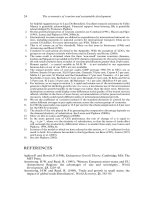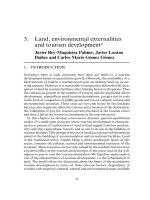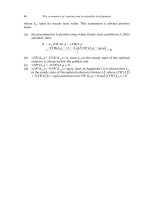THE ECONOMICS OF MONEY,BANKING, AND FINANCIAL MARKETS 311
Bạn đang xem bản rút gọn của tài liệu. Xem và tải ngay bản đầy đủ của tài liệu tại đây (49.28 KB, 1 trang )
CHAPTER 11
Banking Industry: Structure and Competition
279
conduct its international transactions. Second, Eurocurrencies are offshore
deposits they are held in countries that will not subject them to regulations such
as reserve requirements or restrictions (called capital controls) on taking the
deposits outside the country.
The main centre of the Eurocurrencies market is London, a major international
financial centre for hundreds of years. Eurocurrencies are also held outside Europe
in locations that provide offshore status to these deposits for example, Singapore,
the Bahamas, and the Cayman Islands.
The minimum transaction in the Eurocurrencies market is typically $1 million,
and approximately 75% of Eurocurrency deposits are held by banks. Plainly, you
and I are unlikely to come into direct contact with Eurocurrencies. The
Eurocurrencies market is, however, an important source of funds to Canadian banks.
Rather than using an intermediary and borrowing all the deposits from foreign
banks, Canadian banks decided that they could earn higher profits by opening their
own branches abroad to attract these deposits. Consequently, the Eurocurrencies
market has been an important stimulus to Canadian banking overseas.
Canadian
Banking
Overseas
Canadian banks have been present in international financial markets for over 100
years, providing services to Canadians and multinational businesses. As Table 11-4
shows, the international presence of the Big Six varies among the individual
institutions. In particular, the Bank of Montreal, the Canadian Imperial Bank of
Commerce, and TD Canada Trust have a significant presence in the United States,
whereas Scotiabank has established a presence in South America, and the Royal
Bank in Europe and Asia.
During the 1970s and early 1980s a large proportion of the banks foreign lending was in sovereign loans; loans to foreign governments and their agencies in
the less-developed countries (LDCs), particularly Mexico, Brazil, Venezuela,
Argentina, and Chile. Most of this activity in international lending was unregulated,
with near disastrous consequences. One example is the international debt crisis,
which had its origin in the oil price shocks of the 1970s. In particular, the
1973 1974 increase in the price of oil was a bonanza for some oil-exporting countries like Mexico, but a disaster for oil-importing countries like Brazil, which had
to either cut their living standards or borrow massively abroad in order to pay their
higher oil bills. At the time, real interest rates were very low (in fact negative) and
the oil importers couldn t resist the temptation to borrow abroad.
TA B L E 11- 4
Bank
International Activity of the Big Six (as of March 31, 2009)
Primary Focus
Bank of Montreal
United States, Mexico
CIBC
United States
International Assets
($ millions)
Percent of International
Assets in Total Assets
246 618
52%
97 794
27%
Bank of Nova Scotia
South America, Mexico
247 682
47%
Toronto Dominion
United States
295 267
49%
Royal Bank
Europe, Asia
369 121
51%
National Bank
No significant international
presence
21 177
14%
Source: OSFI website, www.osfi-bsif.gc.ca, and authors calculations.









